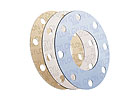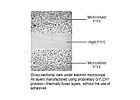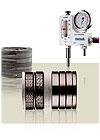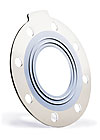

Table.
This compressive load provided by the bolts must be sufficient to cause the gasket to flow into and fill any irregularities in the mating surfaces being sealed. It is also necessary to provide the gripping force between the gasket and flange surface in order to mitigate against lateral gasket movement and blowout. The higher the compressive load - both initially and during service - the better the seal and the higher the blowout resistance.
More than 70% of all gasket failures can be attributed to lack of load, according to multiple studies conducted by Garlock Sealing Technologies. Maintenance engineers, fitters and mechanics must understand the various problems associated with low compressive load and the special gasket solutions that have been developed to address these challenges better than a single, multi-purpose gasket. This will aid in the avoidance of process downtime, safety hazards, environmental damage and messy cleanup nuisance caused by gasket failure.

The Hydra-Just sealing system.
Various Low Load Conditions
Flange MaterialLow load conditions derive from several different causes. Frequently, the problem is caused by structural deficiencies of the flange system. Typically, this occurs in situations where the flange materials were selected for reasons other than mechanical strength, such as chemical inertness or low purchase cost. Generally, non-metallic flanges are used in situations where operating temperatures, pressures and mechanical shock and vibration are less severe. Plastic flanges can be very brittle, and even some metals (like cast iron) have poor ductility. These flanges tend to be less robust (unable to support a high bending stress caused by high bolt load) and therefore require softer, more easily compressed gasket material that can be seated under a lower gasket compressive stress.
The glass-lined flanges found in many chemical applications represent an especially challenging low-load application. Glass surfaces have an inherent “waviness” that results in relatively large gaps between the mating flange surfaces. These gaps require thicker gaskets; Garlock engineers recommend gasket thickness of four to five times the maximum gap. Unfortunately, greater gasket thickness requires higher compressive load. However, the mechanical weakness of glass-lined flanges makes them unable to sustain the increased bolt load typically associated with thick gasket applications. Glass-lined flange applications, therefore, require special gasket solutions that meet the conflicting requirements of filling relatively large gaps and performing with low compressive load.
Flange Geometry
Flange geometry can also limit the system’s ability to sustain high bolt load. For example, the flange thickness may be too thin to support high compressive load.
The flange geometry can not only reduce the system’s capacity to supply load, but it can also increase the demand for compressive load. Problems with flange imperfections and alignment require gasket solutions that often depend on higher compressive load. These problems include non-parallel flanges, distortion troughs and grooves, surface waviness, and surface scorings. When the flange joint contains irregularities, with areas of high and low compression, the areas of low compression are prime candidates for leakage or blowout.
Bolt Material
Bolt material also contributes to the compressive load capacity of the flange system. The bolts in a flange joint system function as a spring. They are an elastic member that has been stretched to develop a load. The more spring provided by the bolt, the better the retention of stress on the gasket to maintain a leakproof joint. The bolt must not be overelongated (over-strained) or the elastic limit of the steel will be exceeded. The bolt then deforms and, with continued loading (stressing), may rupture.
Bolts composed of non-hardened (“as wrought”) stainless-steel materials are often employed because they are less susceptible to corrosion. However, the limited elastic limit (yield point) of these materials compromises the performance of the gasket system. Many plants use stainless steel flanges for chemical service, along with low-strength stainless steel bolts. Although specially designed gaskets can help mitigate the problem of low-strength bolts, Garlock recommends the use of high-strength, strain-hardened stainless steel bolts.
Operating Conditions
Operating conditions can also influence the effective compressive load. For example, hydrostatic end thrust is internal pressure caused by the movement of fluid through the pipe. This force acts to separate the flanges, relieving some of the compressive load applied by the bolts. Operational torque loss, also called stress relaxation, can also be caused by elongation of bolts, thermal cycling, flange distortion and vibration.
Another common problem is creep relaxation, defined by ASTM as: “A transient stress-strain condition in which the strain increases concurrently with the decay of stress.” The result of creep relaxation is loss of thickness of a gasket, which causes compressive load loss that results in leakage.
The gasket itself can be progressively weakened by “aging” (i.e., detrimental changes to the physical properties of the gasket material) or by “fatigue” (i.e., deterioration due to the repetition or continuous application of stress that causes strain).
Gasket Geometry
The issue of gasket thickness was briefly mentioned above in reference to glass-lined flanges. As a rule of thumb, gasket performance decreases as material thickness increases, and compressive loads must be increased with thicker materials. Additional reasons to use thinner gaskets whenever possible include lower gasket purchase cost, as well as enhanced performance of the joint by lowering emissions and product loss and increasing blowout resistance. Thinner gaskets will not seal as many flange irregularities as thicker gaskets, however, and require flatter flanges. Therefore, thicker gaskets sometimes represent the only viable solution despite the increased compressive load requirements.
To decrease compressive load requirements, Garlock also recommends the use of ring gaskets as opposed to full-face gaskets whenever possible. A full-face gasket covers the entire flange surface, including bolt holes. In contrast, ring gaskets are seated concentrically inside the circle of bolts. Accordingly, a ring gasket has considerably less surface area in contact with the flanges compared to a full-face gasket, and therefore significantly less compressive load is required.

Stress Saver sealing ring.
Low Load Solutions
A variety of technology and design strategies have been developed to address the special requirements of low load gasket applications. Three approaches that have proven effective are restructured PTFE gaskets, swelling/self-loading gaskets and engineered molded rubber gaskets.Restructured PTFE
For applications where the flange and bolt system cannot support high compressive loads, Garlock has developed the GYLON®series of gaskets that employ a highly compressible and chemically resistant PTFE material that conforms to surface irregularities under low bolt load. Gaskets are available with a rigid PTFE core sandwiched between outer layers of the highly compressible PTFE material to reduce the cold flow and creep normally associated with conventional PTFE gaskets.
The soft and highly compressible characteristics of the restructured PTFE outer layers allow the gasket to maximize sealing performance despite minimal bolt load.
MULTI-SWELLTM Gaskets
A second strategy - employing material that swells when exposed to water or oil - takes essentially the opposite approach. Rather than being extra compliant to accommodate low bolt load, these swelling gaskets expand and push back, exerting force against the flanges. In other words, they swell when exposed to water or oil (depending on the material composition) to create a counter-force against the bolt load, thereby increasing the effective total compressive load. Garlock has created a self-loading general service gasket specifically designed for low-load applications called the MULTI-SWELLTMgasket, which is twice as soft as conventional gaskets and readily conformable to irregular flanges, even in applications with minimal bolt loads, such as plastic or cast iron flanges.
The new material provides extremely high crush strength and can be safely installed in applications that would typically crush elastomeric gaskets. In applications such as transmissions and air-conditioning systems, where vibration often causes bolt load loss or where load loss occurs because of bolt relaxation, MULTI-SWELL gaskets counter that loss to prevent leakage and weeping.
Engineered Rubber
A third strategy takes advantage of the natural benefits of rubber, a material that offers exceptional softness and nearly 100% resiliency, in the absence of heat. Garlock has built upon these advantages with the Stress Saver®sealing rings by encasing the rubber in PTFE-molded envelopes to provide excellent chemical resistance. The raised, molded-in sealing rings seal with 75% less surface area than full-faced gasket designs for high performance in low-compression applications such as non-metallic flanges.
High Performance Despite Low Load
Low compressive load presents a significant challenge for gasket seals. Three types of gaskets - restructured PTFE gaskets, swelling gaskets and engineered molded rubber gaskets - have proven highly effective in solving the problems caused by low compressive loads. In turn, uniquely engineered gasketing solutions cut maintenance and repair costs, lessen safety concerns associated with blowouts, and reduce emissions and leakage.